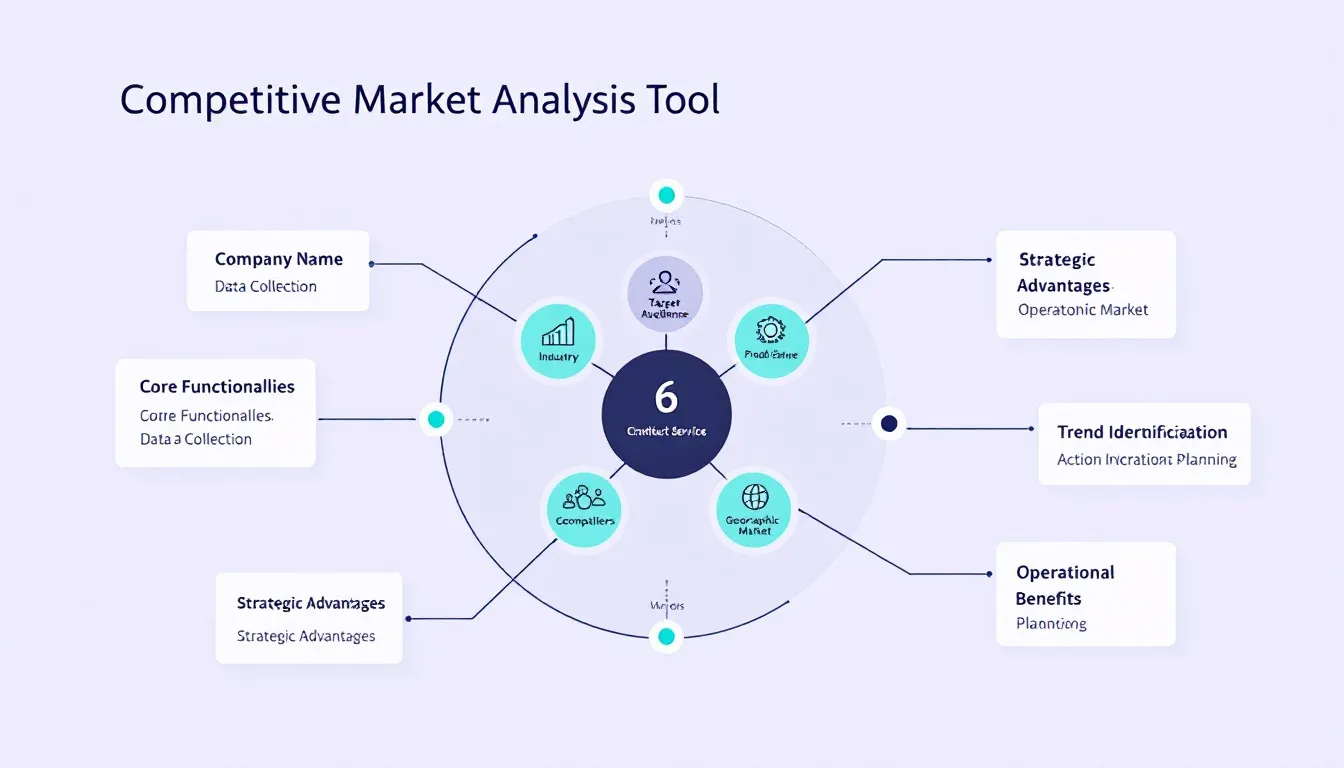Is this tool helpful?
How to Use the Competitive Analysis Market Positioning Tool Effectively
To maximize the benefits of our Competitive Analysis Market Positioning Tool, follow these step-by-step instructions for each field:
Step-by-Step Field Guide
- Company Name: Enter your business name clearly. Example inputs: “TechFlow Solutions” or “Green Earth Organics”
- Industry or Market Sector: Specify your primary business area. Example inputs: “Sustainable Fashion Manufacturing” or “Enterprise Cybersecurity Solutions”
- Target Audience Description: Detail your ideal customer profile, including demographics, behaviors, and needs. Be specific about age ranges, income levels, and pain points.
- Product/Service Description: Outline your core offerings with key features and benefits. Focus on unique selling propositions and value drivers.
- Known Competitors: List major competitors in your market space. While optional, this information enhances analysis accuracy.
- Geographic Market Focus: Define your target market regions to receive geographically relevant competitive insights.
Understanding the Competitive Analysis Market Positioning Tool
This advanced market analysis tool helps businesses identify and analyze their competitive landscape while developing effective differentiation strategies. It combines market intelligence with positioning analysis to provide actionable insights for business growth and market penetration.
Core Functionalities
- Competitor identification and analysis
- Market positioning assessment
- Target audience alignment
- Differentiation opportunity identification
- Strategic recommendations generation
Benefits of Using the Competitive Analysis Tool
Strategic Advantages
- Comprehensive market landscape understanding
- Data-driven positioning decisions
- Enhanced competitive intelligence
- Clear differentiation opportunities identification
- Targeted marketing strategy development
Operational Benefits
- Time-efficient market analysis
- Structured competitive evaluation
- Systematic approach to market positioning
- Actionable insights generation
- Strategic planning support
Problem-Solving Capabilities
Market Positioning Challenges
The tool addresses critical business challenges through systematic analysis:
- Market saturation assessment
- Competitive advantage identification
- Target audience alignment verification
- Geographic market opportunity evaluation
- Product differentiation strategy development
Strategic Implementation
Consider this practical example:
A boutique digital marketing agency, “DigitalPrime Marketing,” specializes in social media management. Their tool analysis revealed:
- Market Position: Premium service provider
- Key Differentiators: AI-powered content optimization
- Target Audience: E-commerce businesses with $1M+ annual revenue
- Geographic Focus: North American market
Practical Applications and Use Cases
Case Study 1: Technology Sector
A cloud storage startup used the tool to:
- Identify 3 main competitors
- Analyze pricing structures
- Develop unique security features
- Target specific industry verticals
Case Study 2: Retail Industry
An eco-friendly fashion brand utilized the analysis to:
- Map sustainable fashion competitors
- Identify price point gaps
- Develop unique value propositions
- Target conscious consumers effectively
Frequently Asked Questions (FAQ)
General Questions
Q: How often should I conduct a competitive analysis?
A: Conduct analyses quarterly or when significant market changes occur to maintain strategic relevance.
Q: Can this tool help with international market analysis?
A: Yes, the tool accommodates global market analysis through its geographic market focus feature.
Q: How detailed should my product description be?
A: Include key features, benefits, and unique selling propositions while keeping descriptions concise and focused.
Q: What makes a good competitor analysis?
A: Focus on direct competitors’ strengths, weaknesses, market positioning, and unique offerings.
Strategic Implementation
Q: How can I use the analysis results effectively?
A: Integrate insights into your marketing strategy, product development, and positioning decisions.
Q: Should I include indirect competitors?
A: Yes, including indirect competitors provides a comprehensive market understanding and identifies potential threats.
Q: How specific should my target audience description be?
A: Include demographics, psychographics, behaviors, and specific needs for optimal analysis.
Best Practices
Q: What’s the best way to differentiate my business?
A: Focus on unique value propositions identified through the analysis and align them with target audience needs.
Q: How can I maximize the tool’s effectiveness?
A: Provide detailed, accurate information and regularly update your analysis as market conditions change.
Q: Should I focus on price or value differentiation?
A: The tool helps identify the most effective differentiation strategy based on your market position and competition.
Additional Considerations
Market Evolution Tracking
Regular competitive analysis helps track market evolution and maintain strategic advantage through:
- Emerging competitor identification
- New market trend analysis
- Changing customer preference monitoring
- Strategic opportunity recognition
Implementation Strategy
For optimal results, implement findings through:
- Strategic planning sessions
- Marketing campaign development
- Product development initiatives
- Customer experience enhancement
Continuous Improvement
Maximize tool benefits through:
- Regular market position reassessment
- Competitive strategy refinement
- Target audience alignment verification
- Differentiation strategy optimization
Important Disclaimer
The calculations, results, and content provided by our tools are not guaranteed to be accurate, complete, or reliable. Users are responsible for verifying and interpreting the results. Our content and tools may contain errors, biases, or inconsistencies. We reserve the right to save inputs and outputs from our tools for the purposes of error debugging, bias identification, and performance improvement. External companies providing AI models used in our tools may also save and process data in accordance with their own policies. By using our tools, you consent to this data collection and processing. We reserve the right to limit the usage of our tools based on current usability factors. By using our tools, you acknowledge that you have read, understood, and agreed to this disclaimer. You accept the inherent risks and limitations associated with the use of our tools and services.







